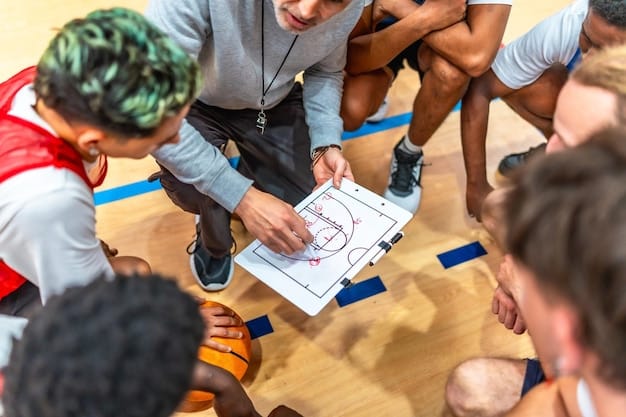How to Start a Local Youth Sports League: Step-by-Step Guide for 2025

Organizing a local youth sports league involves creating a structured athletic program for young athletes, which includes defining the league’s purpose, securing funding, recruiting volunteers, establishing rules, and promoting the league within the community to foster participation and development.
Are you passionate about sports and youth development? Starting a local youth sports league can be a rewarding endeavor. This guide, “**How to Start a Local Youth Sports League: A Step-by-Step Guide for 2025**,” will provide you with the essential steps to create a successful and impactful sports program for your community’s young athletes.
Step 1: Define the League’s Purpose and Scope
Before diving into logistics, it’s vital to clearly define the purpose and scope of your youth sports league. This initial step will serve as the foundation for all subsequent decisions and will guide your league’s development.
Determine the Core Values
What values do you want your league to instill in young athletes? Consider focusing on teamwork, sportsmanship, skill development, and community involvement. These values should be reflected in all aspects of the league, from coaching to competition.
Identify the Target Age Group and Sports
Decide which age groups you’ll cater to (e.g., 8-10 years old, 11-13 years old). Select the sports that will be offered, considering the local community’s interests and available resources. Popular choices include soccer, baseball, basketball, and flag football.
- Conduct a community survey to gauge interest in specific sports.
- Assess the availability of facilities and equipment for different sports.
- Consider the potential for attracting volunteer coaches and sponsors for each sport.
Defining the purpose and scope ensures your league has a clear identity and direction, making it easier to attract participants, volunteers, and sponsors. It also helps in creating a program that aligns with the community’s needs and values.

Step 2: Develop a Business Plan and Secure Funding
A comprehensive business plan is crucial for securing funding and ensuring the long-term sustainability of your youth sports league. This plan outlines your league’s goals, strategies, and financial projections.
Create a Detailed Budget
Estimate the costs associated with running the league, including facility rentals, equipment purchases, insurance, referee fees, marketing, and administrative expenses. Identify potential revenue streams such as registration fees, sponsorships, and fundraising events.
Explore Funding Options
Research various funding opportunities, including grants from local organizations, sponsorships from businesses, and fundraising events. Develop a compelling pitch to attract sponsors and donors who align with your league’s mission.
- Apply for grants from foundations that support youth sports and community development.
- Offer sponsorship packages with different levels of visibility and benefits.
- Organize fundraising events like car washes, bake sales, and sports tournaments.
A well-crafted business plan provides a roadmap for your league’s financial success. Demonstrating financial stability and responsible management will increase your chances of securing the necessary funding to launch and sustain your program.
Step 3: Recruit Volunteers and Establish a Board
Volunteers are the backbone of any successful youth sports league. Recruiting dedicated individuals and establishing a strong board of directors will provide the necessary support and guidance for your organization.
Recruit Coaches and Assistant Coaches
Seek out individuals with experience in coaching and a passion for working with young athletes. Conduct background checks and provide training on coaching techniques, safety protocols, and league rules.
Form a Board of Directors
Assemble a board of directors with diverse skills and expertise in areas such as finance, marketing, legal, and sports management. The board will be responsible for overseeing the league’s operations, making important decisions, and ensuring compliance with regulations.
- Create a volunteer application process with clear roles and responsibilities.
- Offer volunteer appreciation events to recognize and reward their contributions.
- Develop a comprehensive board governance structure with defined roles and responsibilities.
Having a strong team of volunteers and an engaged board of directors will ensure that your league operates effectively and provides a positive experience for all participants. Their dedication and expertise will be invaluable in achieving your league’s goals and objectives.
Step 4: Develop Rules and Regulations
Establishing clear rules and regulations is essential for ensuring fair play, safety, and a positive experience for all participants. These rules should cover all aspects of the league, from game play to code of conduct.
Create a Code of Conduct
Develop a code of conduct for players, coaches, parents, and spectators that emphasizes sportsmanship, respect, and fair play. Clearly outline the consequences for violating the code of conduct.
Establish Game Rules
Adapt the official rules of the sport to suit the age and skill level of the players. Ensure that the rules are easy to understand and enforce consistently across all games.
- Distribute the code of conduct and game rules to all participants before the season begins.
- Enforce the rules consistently and fairly.
- Provide a clear process for resolving disputes and addressing grievances.
Well-defined rules and regulations create a safe and structured environment for young athletes to learn and compete. Consistent enforcement of these rules promotes fair play, respect, and a positive sporting experience for everyone involved.
Step 5: Promote the League and Recruit Players
Effective promotion is crucial for attracting players and building awareness of your youth sports league within the community. Utilize various marketing channels to reach your target audience and generate interest in your program.
Utilize Social Media
Create social media profiles on platforms like Facebook, Instagram, and Twitter to share updates, photos, and videos of your league. Engage with your audience by posting regularly and responding to comments and questions.
Partner with Local Schools and Organizations
Collaborate with local schools, community centers, and youth organizations to promote your league and reach potential players. Offer presentations, demonstrations, and introductory clinics to generate interest.

- Create flyers and posters to distribute in schools and community centers.
- Offer early bird registration discounts to incentivize sign-ups.
- Host a free open house or sports clinic to showcase your league.
By actively promoting your league and engaging with the community, you can attract a diverse group of players and build a strong foundation for your program’s success. Word-of-mouth marketing and positive reviews from satisfied participants will further enhance your league’s reputation and attract even more players in the future.
Step 6: Manage Registration and Team Formation
A smooth and efficient registration process is essential for creating a positive first impression for potential players and their families. Clear communication and organized team formation are key to a successful season.
Implement an Online Registration System
Utilize an online registration platform to streamline the sign-up process and collect player information. This will simplify administrative tasks and provide a convenient way for parents to register their children.
Form Balanced Teams
Develop a fair and equitable method for forming teams, taking into account factors such as age, skill level, and experience. Consider conducting player evaluations or tryouts to ensure balanced teams that promote fair competition.
- Provide clear instructions and support for parents during the registration process.
- Communicate team assignments and schedules well in advance of the season.
- Offer a waiting list option for players who register after the deadline.
A well-managed registration process and balanced team formation contribute to a positive and enjoyable experience for all participants. Clear communication, efficient organization, and fair team assignments will set the stage for a successful and competitive season.
Step 7: Conduct Training and Games
Providing quality training and well-organized games is the heart of any youth sports league. Focus on skill development, sportsmanship, and creating a positive and supportive environment for young athletes.
Schedule Regular Practices
Establish a consistent practice schedule that allows players to develop their skills and learn teamwork. Provide coaches with resources and training on effective coaching techniques and age-appropriate drills.
Organize Fair and Competitive Games
Create a game schedule that provides opportunities for all teams to compete against each other. Ensure that games are officiated fairly and that coaches emphasize sportsmanship and respect for opponents.
- Provide coaches with ongoing training and support throughout the season.
- Recognize and reward players for demonstrating good sportsmanship and effort.
- Encourage parent involvement and create a positive atmosphere at games.
By focusing on quality training and well-organized games, you can create a positive and enriching experience for young athletes. Skill development, teamwork, and sportsmanship are key elements to fostering a love of sports and promoting a healthy lifestyle.
| Key Aspect | Brief Description |
|---|---|
| ⚽️ League Purpose | Define mission & target age for sports offered. |
| 💰 Funding | Create budget, seek grants, sponsorships & fundraise. |
| 🧑🤝🧑 Volunteers | Recruit coaches & a board; define roles. |
| 📝 Rules | Establish a code of conduct and clear game regulations. |
FAQ
▼
Begin by defining your league’s purpose, scope, and core values. Determine the sports to offer and the age groups to target. Conduct community surveys to assess interest and resource availability.
▼
Develop a detailed budget and explore funding options such as grants, sponsorships, and fundraising events. Create a compelling pitch to attract sponsors and demonstrate financial responsibility.
▼
Recruit coaches and assistant coaches who have experience and passion for working with young athletes. Create a volunteer application process and establish a strong board of directors with diverse skills.
▼
Clear rules and regulations ensure fair play, safety, and a positive experience for all participants. A code of conduct and game rules promote sportsmanship, respect, and a structured environment for young athletes.
▼
Utilize social media, partner with local schools, and offer introductory clinics. Create flyers and posters for distribution and provide early bird registration discounts to incentivize sign-ups and participation.
Conclusion
Starting a local youth sports league is a challenging yet incredibly rewarding endeavor. By following these steps, you can create a positive and impactful sports program that benefits your community’s young athletes for years to come. Remember to stay organized, communicate effectively, and prioritize the well-being and development of the children under your care.





